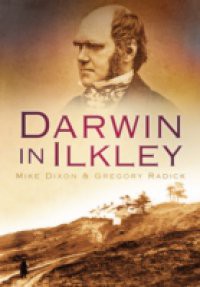When the Origins of Species was published on 24 November 1859, its author, Charles Darwin, was near the end of a nine-week stay in the remote Yorkshire village of Ilkley. He had come for the 'water cure' - a regime of cold baths and wet sheets - and for relaxation. But he used his time in Ilkley to shore up support, through extensive correspondence, for the extraordinary theory that the Origin would put before the world: evolution by natural selection. In Darwin in Ilkley, Mike Dixon and Gregory Radick bring to life Victorian Ilkley and the dramas of body and mind that marked Darwin's visit. Review in British Medical Journal, 4th Feb 2010Darwin’s water on the brainby Gerry Shaper, emeritus professor of clinical epidemiology University College Medical School, London Can a book about Darwin’s nine weeks in Ilkley add to the vast amount of material published to coincide with his 2009 anniversaries, asks Gerry Shaper. In 2009 Ilkley in West Yorkshire won the Royal Horticultural Show’s Britain in bloom silver award for its floral decoration, but in 1859 it was an unattractive rustic village, not yet connected by railway to Leeds or Bradford and accessible only by horse drawn coach. Why Darwin chose Ilkley for his "water cure" when there were many other establishments, some of which much nearer to Down House he had tried out, remains uncertain. But Ilkley it was, and to the Wells House Hydro run by Dr Edmund Smith, a homoeopathist, a treatment option that Darwin despised. But Darwin had a solution to his stay among the "sick and suffering of the upper classes-the effete, the neurotic, the halt, and the lame." He wrote an affectionate letter to Miss Mary Butler, a lively, witty, and attractive Irish woman who he had met while staying at a hydro in Surrey some six months earlier, and she duly joined him at the Wells House Hydro. This is no cringing recluse, no chronic invalid shunning society. Darwin becomes a playful admiring man of 50, charmed by pretty and intelligent women and quite happy to discuss his theories with them. Our feelings for Darwin the man begin to mellow. We must add that the ever watchful Mrs Darwin was quick to join her husband in Ilkley, bringing some of the children, and moving him out of Wells House and into a rented house. But the seven weeks in Ilkley before the publication of On the Origin of Species by means of Natural Selection was not all beauty and billiards and not all wet towels, cold douches, and walks on Ilkley moor. Darwin was busy with the final corrections and engaging in an intense correspondence with all the key players in the final run-up to publication on 24 November. He was determined to mould minds and opinions and to woo the unconvinced to his firmly established belief in transmutation and its major mechanism. The critical final debate centred on Sir Charles Lyell, the geologist whose work had inspired Darwin during the voyage of the Beagle and who engaged Darwin in intense debate on the origin of domesticated dogs and the role of God. Their correspondence is fascinating and beautifully presented. It was for Darwin the last bastion in his struggle to persuade Lyell to his side of the argument. This exchange of fundamental views took place in North House, the rented property housing Emma and the children. After the spartan diet and daily routine of Wells House Hydro, it was back to home cooking: Emma was great on milk, butter, and cream. And with the return to domestic life came the return of Darwin’s symptoms of chronic illness. Darwin’s campaign to seek approval involved the despatch of some 80 presentation copies of Origin, all accompanied by carefully tailored letters-to family; to English naturalists in his own immediate circle, including Alfred Russell Wallace; to other English naturalists outside this circle ("the mob"); and to foreign men of science. "If I am in the main right, the admission of my views will depend more on men like yourself, with well established reputations, than on my own writings." The material in this slim volume on Darwin’s illness and its failure to respond to many of the treatments of the day and the delightfully illustrated descriptions of the water cure add pleasure to this story. Darwin did have periods of respite from his illness, and the authors present a compelling argument for rejecting the diagnosis of hypochondria put forward by many, including Sir George Pickering and more recently Brian Dillon (BMJ 2009;339:b3889, doi:10.1136/bmj.b3889). It seems that it was a matter of "hotel (hydro) good-home care bad." Darwin said, "Most regular medical men sneer at the Water-cure, but I have tried it repeatedly and always with wonderful good effects, but not permanent in my case." The diagnosis of lactose intolerance (sensitivity) is made and the argument is well sustained and convincing. Darwin may intuitively have realised that home and home cooking had an ominous significance, hence his apparently unscientific choice of the water treatment centres. Hypochondria seems an unlikely diagnosis when you bear in mind the considerable difficulties and delays in his work that his symptoms occasioned. "Darwin’s genetic make-up . . . and enigmatic illness, represent a failure to conform to an adaptation (persistent lactase production) that, through natural selection, prevails in the general population. Darwin, as with so much else in his remarkable life, did not follow the herd." Centred around the time of publication of On the Origin of Species, this delightful, informative, and well illustrated book takes us closer to the mind and manner of Darwin than many more detailed and extensive bibliographies. It is a worthy and valuable addition to 2009’s output of anniversary volumes.

